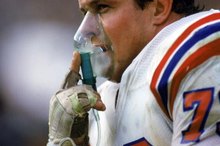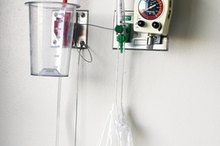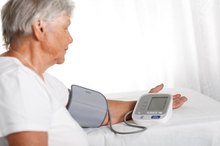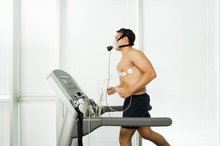How to Calculate Oxygen Amount According to Liter Flow
If you have breathing problems, supplemental oxygen is an important part of your medical plan. Whether you are on oxygen temporarily or everyday, how much oxygen you get is vital to your well-being. Your doctor calculates how much oxygen you need in percentages 1. Those percentages correlate to the number on the oxygen dial, called a flow meter 1. The number on the dial is called the liter flow. Your liter flow will vary with different types of oxygen tubes. Your health care providers are trained in monitoring your oxygen liter flow. Regardless of what type of oxygen tube you use, knowing how many liters you need is important to your health.
Inspect the type of oxygen that is being used. Even if the liter flow number is the same, different types of oxygen systems will deliver different amounts of oxygen. This is why it is important for you to understand what the liter flow number means when it is attached to each type of oxygen setup.
How to Use a Venturi Mask
Learn More
Note that when a nasal cannula is used for oxygen, the liter flow number will be set between 1 and 6 liters. When the dial is set at 1 liter, 24 percent oxygen is being delivered. For each increase in the number on the flow meter dial, the amount of oxygen delivered increases by 4 percent. If the flow meter is set at 2 liters, the oxygen delivered goes up to 28 percent. The highest level of liters allowed is 6 and delivers 44 percent oxygen.
Recognize that when a simple face mask is used, the percentage of oxygen delivered is an estimate. The flow meter should be set between 5 and 12 liters. The amount of oxygen delivered will be 40 to 60 percent. The flow meter should never be set less than 5 liters with this type of mask.
How to Set Up the Flow Meter on a Oxygen Concentrator
Learn More
Observe that a partial rebreather oxygen mask will deliver 35 to 60 percent of oxygen. The flow meter will be set between 8 and 15 liters. The flow meter should never set below 8 liters. The liter flow is based on your observation of the reservoir bag. The bag must be kept half inflated. You will need to increase the liter flow if the bag is not inflated enough.
Notice that a non-rebreather oxygen mask looks similar to a rebreather mask. You will set your liter flow dial between 8 and 15 liters. This type of mask will deliver 60 to 90 percent of oxygen to your patient. The attached reservoir bag must always be about half full. You may need to increase the liter flow to keep the bag inflated. Never decrease the liter flow to less than 8 liters.
Determine if your patient is using a venti mask for oxygen delivery. This type of mask is always set at 15 liters on the flow meter. The mask has changeable plastic pieces, in a variety of colors. Each color signifies a different percentage of oxygen delivery. Venti masks, also called variable or Venturi masks, are capable of delivering between 24 and 50 percent of oxygen. The liter flow does not change the amount of oxygen delivered. You must always change the plastic adapter to do that.
Warnings
Never increase or decrease oxygen without your doctor's permission.
Not adhering to facility protocols for liter flow amounts can cause dangerous levels of CO2 to build up inside oxygen face masks.
Related Articles
References
- Critical Care Medicine Tutorials: Oxygen
- Things to Know When Using Oxygen Therapy. American Lung Association. August 23, 2018
- The Long-Term Oxygen Treatment Trial Research Group. A Randomized Trial of Long-Term Oxygen for COPD with Moderate Desaturation. The New England Journal of Medicine. 2016;375(17):1617-1627. doi:10.1056/NEJMoa1604344.
- American Lung Association. Supplemental Oxygen. 2017.
- Shah SA, Velardo C, Farmer A, Tarassenko L. Exacerbations in Chronic Obstructive Pulmonary Disease: Identification and Prediction Using a Digital Health System. Eysenbach G, ed. Journal of Medical Internet Research. 2017;19(3):e69. doi:10.2196/jmir.7207.
- Turan O, Ure I, Turan PA. Erectile dysfunction in COPD patients. Chron Respir Dis. 2016;13(1):5–12. doi:10.1177/1479972315619382
- Traveling with Oxygen. American Lung Association. October 3, 2018
- Nishimura M. High-flow nasal cannula oxygen therapy in adults. J Intensive Care. 2015;3(1):15. Published 2015 Mar 31. doi:10.1186/s40560-015-0084-5
- Abdo WF, Heunks LM. Oxygen-induced hypercapnia in COPD: myths and facts. Crit Care. 2012;16(5):323. Published 2012 Oct 29. doi:10.1186/cc11475
- American Thoracic Society. Patient Education Information Series. Oxygen Therapy. 2016.
Warnings
- Never increase or decrease oxygen without your doctor's permission.
- Not adhering to facility protocols for liter flow amounts can cause dangerous levels of CO2 to build up inside oxygen face masks.









